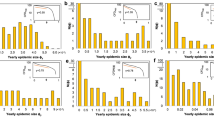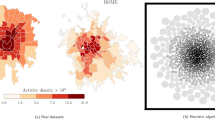Abstract
Responding to a possible bioterror attack of Smallpox has become a major concern to governments, local public officials and health authorities. This concern has been reflected in numerous studies that model and evaluate possible response strategies. Many of these studies consider only vaccination policies and assume homogeneous mixing, where all instances of contacts in the population are equally likely. Such a mixing pattern is rather unlikely to represent population interaction in a modern urban setting, which typically is separated into households on the one hand, and into daily meeting sites such as schools and offices, on the other hand. In this paper we develop a two-level social interaction model where an individual moves back and forth between home and a daily meeting site, possibly passing through a general meeting site such as mass transit system or other crowded areas. Based on the model, we evaluate the effect of social mixing controls, situational awareness of the public health system and mass vaccination on the spread of smallpox. It is shown that mixing controls and alertness of the response system may have a significant impact on the spread of the epidemic. Some policy recommendations are discussed.
Similar content being viewed by others
References
E.H. Kaplan, D.L. Craft, and L.M. Wein, Emergency response to a smallpox attack: The case for mass vaccination, Proceedings of the National Academy of Science 99(16) (2002) 10935–10940.
E.H. Kaplan, D.L. Craft, and L.M. Wein, Analyzing bioterror response logistics: The case of smallpox, Math. Biosci. 183 (2003) 33–72.
S.A. Bozzette, R. Boer, V. Bhatnagar, J.L. Brower, E.B. Keeler, S.C. Morton, and M.A. Stoto, A model for a smallpox-vaccination policy, The New England Journal of Medicine 348(5) (2003) 416–425.
M.I. Meltzer, I. Damon, J.W. LeDuc, and J.D. Millar, Modeling potential responses to smallpox as a bioterrorist weapon, Emerging Infectious Diseases 7(6) (2001) 959–969.
M. Kress, Policies for Biodefense Revisited: The Prioritized Vaccination Process for Smallpox, Naval Postgraduate School, NPS-OR-03-008, Monterey, CA. (2003).
M.E. Halloran, I.M. Jr. Longini, N. Azhar, and Y. Yang, Containing bioterrorist smallpox, Science 298 (2002) 1428–1432.
N.M. Ferguson, M.J. Keeling, W.J. Edmunds, R. Gani, B.T. Grenfell, R.M. Anderson, and S. Leach, Planning for smallpox outbreaks, Nature 425 (2003) 681–685.
J. Koopman, Controlling smallpox, Science 298 (2002) 1342–1344.
M.J. Keeling, The effects of local spatial structure on epidemiological invasion, Proc. R. Soc. Lond. B 266 (1999) 859–867.
M. Kretzschmar and M. Morris, Measures of concurrency in networks and the spread of infectious disease, Math. Biosci. 133 (1996) 165–195.
F.G. Ball and O.D. Lyne, Optimal vaccination policies for stochastic epidemics among a population of households, Math. Biosci. 177–178 (2000) 333–354.
J.S. Koopman, S.E. Chick, C.P. Simon, C.S. Riolo, and G. Jacquez, Stochastic effects on endemic infection levels of disseminating versus local contacts, Math. Biosci. 180 (2002) 49–71.
E.H. Kaplan, Can bad models suggest good policies? sexual mixing and the AIDS epidemic, The Journal of Sex Research 26(3) (1989) 301–314.
E.H. Kaplan, Mean-max bounds for worst-case endemic mixing models, Math. Biosc. 105 (1991) 97–109.
J.A. Jacquez, C.P. Simon, and J. Koopman, Structured Mixing: Heterogeneous Mixing by the Definition of Activity Groups, Lecture Notes in Biomathematics 83 (1989) 301–315.
D.J. Watts and D.S. Strogatz, Collective dynamics of small-world networks, Nature 393 (1998) 440–442.
D.J. Watts, Six Degrees—The Science of Connected Age (W.W. Norton & Company, 2003).
E. Ahmed, A.S. Hegazi, and A.S. Elgazzar, An epidemic model on small-world networks and ring vaccination, Intl. Journal of Modern Physics C 13(2) (2002) 189–198.
E. Eubank, H. Guclu, V.S.A. Kumar, M.V. Marathe, A. Srinivasan, Z. Toroczkai, and N. Wang, Modelling disease outbreaks in realistic urban social network, Nature 429 (2004) 180–184.
D.P. Gaver, P.A. Jacobs, G. Bullock, and R. Simons, Models for transmission and control of bioterroristic epidemics, Naval Postgraduate School, NPS-OR-04-006, (Monterey, CA, 2004).
L. Brouwers, MicroPox: A large-scale and spatially explicit microsimulation model for smallpox transmission, Working Paper, Stockholm Group for Epidemic Modeling, Dept. of Epidemiology, Swedish Institute for Infectious Disease Control (2005).
R.M. Anderson and R.M. May, Infectious Diseases of Humans: Dynamics and Control, (Oxford Science Publications, 1999).
R. Gani and S. Leach, Transmission control of smallpox in contemporary populations, Nature 414 (2001) 748–751.
N.L. Johnson and S. Kotz, Urn models and their Application: An Approach to Modern Discrete Probability Theory, (Wiley, 1977).
Author information
Authors and Affiliations
Corresponding author
Rights and permissions
About this article
Cite this article
Kress, M. The Effect of Social Mixing Controls on the Spread of Smallpox—A Two-Level Model. Health Care Manage Sci 8, 277–289 (2005). https://doi.org/10.1007/s10729-005-4138-4
Received:
Accepted:
Issue Date:
DOI: https://doi.org/10.1007/s10729-005-4138-4




